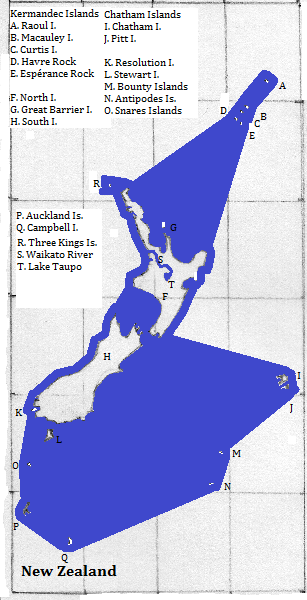
| To Duval Family Home Page | Oceania |
| To Chris Home Page | New Zealand and its possesions |
| To Earth (Geography Home Page) |
The nation consists of two large islands and numerous small ones,
South Island, Oceania's second largest, is more conventionally shaped--a long thin rectangle from northeast to southwest--and conventionally mountainous, rising to nearly 4,000 meters. Small coastal plains are mostly on the east side. The two islands are separated by Cook Strait.
Five sets of islands together are honored by UNESCO as a World Heritage Site: the Snares, the Bounty Islands, the Antipodes; the Auckland Islands and Campbell Island. Another UNESCO site is the 'Te Wahipounamu-South West New Zealand,' which includes the national parks of: Aoraki/ Mt. Cook; Fiordland; Mt. Aspiring; and Westland. The Franz Josef Glacier in the last park is a tourist attraction, as is Milford Sound in Fiordland National Park. The last of the UNESCO honors goes to Tongariro National Park. Other rural tourist spots include: the Coramendel Peninsula; Abel Tasman National Park; Kaikoura; and the Bay of Islands.

Almost nineteen in twenty speak English as a first language; the rest use various languages represented elsewhere in the Pacific and beyond, and English secondarily.
Six in ten are practicing Christians; most of the rest are non-observant of Christian descent. Protestants are almost 80 percent of the Christians; Roman Catholics most of the rest. More than a third of the Protestants are Anglican and more than a quarter are Presbyterian.
Only one city has a metropolitan area over one million: Auckland (pronounced like Oakland). The city sprawls along and near a narrow neck of land between harbors at the base of the northwest peninsula. Other cities or urban areas of note are: Napier-Hastings; Rotorua; Christchurch; and Wellington.
Perhaps 800 years ago,
Europeans arrived in the 19th century, establishing English and Christianity.
north, east and south
west of South Island
northwest of North Island
1. Including the Kermadec Islands, Chatham Islands, Snares Islands, Bounty Islands, Antipodes Islands, Auckland Islands, and Campbell Island, as well as the main two islands and others in their immediate vicinity.
2. Auckland has 1,413,700 in the urban area, which is smaller than the city. The Napier-Hastings area has 128.8 thousand (60.1 thousand in Napier). Rotorura has 56.2 thousand in its urban area. Christchurch has 375.2 thousand in its urban area and 363 thousand under the city council. Wellington has 393.6 thousand in its urban area and 200.1 thousand under the city council. Sources: https://en.wikipedia.org/wiki/Urban_areas_of_New_Zealand and https://en.wikipedia.org/?title=List_of_cities_in_New_Zealand both accessed 6/22/2015.
3. https://en.wikipedia.org/wiki/List_of_the_busiest_airports_in_New_Zealand, accessed 6/22/2015.
4. https://en.wikipedia.org/wiki/List_of_natural_gas_fields, accessed 6/22/2015.
5. Archaeology and dating by the ecological destruction caused by human settlement support this date, or one more recent; some argue for an earlier date.